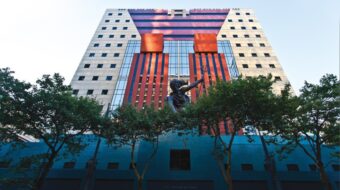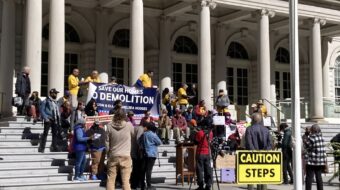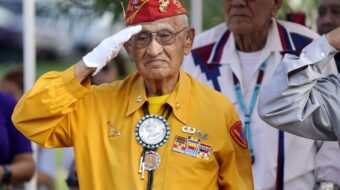
Photographer Milton Rogovin has used his camera to take us into the world of workers, showing us their humanity, dignity and strength. He has photographed in the steel factories of Buffalo, N.Y., in the coal mines of Appalachia and nine other countries, in African American storefront churches, in the working-class community of Buffalo’s Lower West Side, on Native American reservations and in the Yemeni community of Lackawanna, N.Y. At the invitation of Chilean poet Pablo Neruda, he stayed at Neruda’s house while he photographed the Chilean people.
What’s new, exciting and gratifying for Rogovin, now 96, is that people are finally enjoying, understanding and learning from his photography.
When he refused to testify before the notorious House Un-American Activities Committee (HUAC) in 1957, Rogovin was branded “Buffalo’s number one Red” in the headlines of the Buffalo Evening News. Now he is treated as Buffalo’s number one photographer.
The same government that persecuted Rogovin and his family has honored his work by acquiring his photographs for the Library of Congress. Once he and his family were shunned and isolated. Now people wait in line for his autograph. He has received honorary doctorate degrees and has won numerous awards, including the 1996 Citizen of Distinction Award from the city of Buffalo. His photographs have been collected and exhibited internationally and are in major museum collections worldwide.
The sting of injustice
Born in New York City in 1909, the daily suffering that Rogovin witnessed and experienced during the Depression of the 1930s had a lasting impact on him. Graduating from Columbia University in 1931 with a degree in optometry and a deep concern for the rights of workers, he began to question why so many people were unemployed.
“I could no longer be indifferent to the problems of people, especially the poor, the forgotten ones,” he said in a recent interview. Wanting to help create a more just and humane society through socialism, he joined the Communist Party USA and became active in organizing the Optical Workers Union in New York City.
When he moved to Buffalo in 1938 for a job, Rogovin continued with his union work, helping to reorganize United Optical Workers Local 951. Losing his job due to his union activity, Rogovin opened his own optometry office, providing services mainly to the city’s union members.
By the time the Cold War began heating up in the 1950s, Milton had married, served in the Army and had three children. He and his wife Anne continued with their union and other political work, including voter registration in Buffalo’s African American community and protesting the arrest of Ethel and Julius Rosenberg, who were falsely accused of spying for the Soviet Union and executed.
Because of McCarthyism, the anticommunist hysteria of the time, Rogovin’s optometry practice was severely reduced. The hardest part, however, was the isolation his children suffered. No other children were allowed to play with the Rogovin children.
Storefront Church series
Rogovin’s first photographic project in Buffalo was the “Storefront Church” series in the city’s African American community. He was invited by his friend William Tallmadge, a music professor at Buffalo State College, to take pictures at the church services while Tallmadge recorded the music. The project was finished in three months but Rogovin decided to do an in-depth study. His political voice silenced, he realized he could use his photography to speak for him to make people aware of social and political injustice.
Every Sunday for three years he went to the storefront churches to take pictures. At first people were suspicious of him, but he always returned with pictures to give to everyone he had photographed and soon people got to know him and they welcomed him.
Thirty photographs from this series were printed in the magazine Aperture in 1962. W.E.B. Du Bois, a founder of the National Association for the Advancement of Colored People, had encouraged Rogovin to do the series and wrote an introduction for this work, which also included an excerpt from Du Bois’ “Souls of Black Folk.” Du Bois said the photographs are “astonishingly human and appealing.” They reminded him of how “little the church of America and other institutions of our culture” have reached “the poor, Black workers, recently come to cities like Buffalo” and “how alone and segregated they live and worship.”
It was while working on the storefront churches that Rogovin decided to work in a series rather than use his photographs as individual images.
Anne Rogovin, Milton’s wife of 61 years, is the perfect example of the saying, “Behind every successful man is a strong woman.” She was his supporter, collaborator, organizer and travel companion. She was also a special education teacher, an author, a peace activist and mother of three children. Anne, who passed away in 2003, had a wonderful personality that helped to open many a door that might otherwise be closed to a man with a camera.
Lower West Side
Rogovin’s optometry office on Chippewa Street in Buffalo bordered on the Lower West Side, a working-class Italian neighborhood that was becoming home to African American, Puerto Rican, Native American and poor white families. There was a high rate of unemployment and all the social problems that poverty creates. In 1972, Rogovin began walking in the neighborhood, asking people if he could take their picture. Initially, people were suspicious of him, thinking the FBI, police or welfare department was spying on them. However they soon realized that Milton and Anne, who accompanied him, were their friends, and they invited them to their homes, community centers, weddings and other family gatherings.
The only direction Rogovin gave was telling people to “look at the camera.”
“When I saw their eyes, I knew it was time to make their picture. … Look into the people’s eyes and let them speak …they open their hearts to you … they tell you their life story,” says Rogovin.
At the urging of Anne, Rogovin returned in the early 1980s and again after recovering from heart surgery and prostate cancer in the 1990s to photograph the same people he filmed in the first 1970s series. These pictures taken of the same people over a period of 20 years became his “Triptych” series. They show the passage of time, telling the life stories of individuals and families. We see children grow into teenagers and then parents, parents become grandparents, we see partners change, we see lost human potential, illness, endurance, survival and we see death.
Losing his eyesight to cataracts, Rogovin sold his camera and dismantled his darkroom in 1997, thinking he would never photograph again. However, after his vision was restored by surgery, David Isay, a documentary radio producer, suggested that Milton return to the Lower West Side one more time. Milton bought back his camera and at the age of 91 he and Anne, accompanied by Isay and filmmaker Harvey Wang, returned to photograph for the fourth time the individuals and families that Milton had begun photographing in the 1970s. The photographs joined the “Triptych” series to become “Quartets.” Isay and his partner David Miller interviewed some of the families, which together with the pictures became part of the book, “The Forgotten Ones.”
Harvey Wang’s “The Forgotten Ones,” a documentary of Milton and Anne photographing “Quartets,” won best documentary short film at the 2003 Tribeca Film Festival in New York City. This month it won best short documentary at the International Fest of Cinema and Technology.
Working People
With encouragement from Anne and his children, Milton retired from his optometry practice in 1978 to devote all his time and energy to his photography. Inspired by Bertolt Brecht’s poem “A Worker Reads History,” he started his “Working People” series.
“Who built the seven gates of Thebes? The books are filled with names of kings. Was it kings who hauled the craggy blocks of stone? And Babylon, so many times destroyed, Who built the city up each time?” Brecht wrote.
Rogovin went into the Buffalo and Lackawanna steel factories and foundries and auto and electrical plants to photograph men and women on the job, many covered with dirt and sweat, and then photographed them at home with their families or prized possessions. He wanted to pay tribute to the workers, many who worked in hot, dirty and dangerous jobs, making the steel that built this country and the cars and appliances that had become such an important part of our lives.
After the steel mills closed, Rogovin went back in 1987 to re-photograph the same workers. Michael Frisch, at the time a professor of history and American studies at the State University of New York at Buffalo and the editor of the Oral History Review, accompanied Rogovin and interviewed and recorded the workers who spoke about working in the steel mills and the changes in their lives after the mills shut down. This resulted in “Portraits in Steel.”
Family of Miners
Anne and Milton began traveling to Appalachia in the 1960s, returning year after year, to photograph coal miners, covered with coal dust, at their dangerous work in the mines and then at home with their families. In the 1980s, Rogovin was awarded the W. Eugene Smith Award for Documentary Photography which allowed him and Anne to travel to Scotland, Spain, Germany, France, China, Mexico, Zimbabwe, Czechoslovakia and Cuba to photograph miners in those countries for his “Family of Miners” series.
“The rich have their own photographers. I photograph the poor … the forgotten ones,” Rogovin says. Thanks to Milton Rogovin, generations to come won’t forget the humanity, dignity and strength of working people.
Eileen Reardon is a community activist and reader of the World in Buffalo, N.Y.
Milton Rogovin’s photographs are available for display in the form of an inexpensive, traveling exhibit meant for union halls, community centers, libraries, colleges and nontraditional galleries. Professionally curated by Rogovin’s son, Mark, the exhibit includes introductory remarks by author Studs Terkel. A selection of Rogovin’s books, including the new “Milton Rogovin: The Mining Photographs,” is also available from the same source: the Syracuse Cultural Workers. For more information, www.syrculturalworkers.com; (315) 474-1132, or www.miltonrogovin.com.











